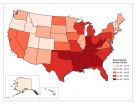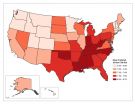New state level data demonstrate geographical variation in 10-year cardiovascular risk
Information can help target intervention programs, according to report in the American Journal of Preventive Medicine
2014-11-10
(Press-News.org) Ann Arbor, MI, November 10, 2014 -- Public health researchers seeking to determine an individual's risk of developing cardiovascular disease (CVD), coronary heart disease (CHD), or stroke have previously relied on national US data, such as that provided by the National Health and Nutrition Examination Surveys (NHANES). Now, new data compiled and evaluated by researchers at the Centers for Disease Control and Prevention (CDC) provide information at the state level for the first time, paving the way for targeted intervention programs. Their results appear in the American Journal of Preventive Medicine.
Nearly 800,000 people die each year from CVD, making it the leading cause of death in the US. Although CVD mortality has continued to decline during the past 40 years, the rates of decline varied significantly among the states. Across states, significant variation has been described in the prevalence of CVD and cardiovascular health and risk factors, including hypertension, smoking, high blood cholesterol, diabetes, overweight/obesity, physical inactivity, and limited consumption of vegetables and fruits.
"Although all states with high levels of predicted 10-year CVD risk are in need of interventions, the states with the highest predicted risk need even more interventions to effectively reduce the disparities in CVD morbidity and mortality," says Barbara A. Bowman, PhD, the director of the CDC's Division for Heart Disease and Stroke Prevention, Atlanta, GA.
The predicted 10-year risks of developing CVD varied significantly by age, gender, race-ethnicity, educational attainment, household income, and state of residence. Among men, the mean age-standardized predicted 10-year risk of developing CVD ranged from a low of 13.2% in Utah to a high of 16.2% in Louisiana. The risk was considerably lower in women, with a low of 6.3% in Minnesota to a high of 8.7% in Mississippi. The higher risks tended to cluster in the southeastern states and the lower risks in northwestern states.
In addition to the state-specific data, the study also included national results. For instance, the age-standardized mean CVD, CHD, and stroke Risk Score (RS) for adults aged 30-74 years was 14.6%, 10.4% and 2.3% for men and 7.5%, 4.5%, and 1.8% for women, confirming that the risks are nearly twice as high for men as for women. Risk increased significantly with age, and was highest among non-Hispanic blacks, those who had less than a high school education, and those with household incomes below $35,000.
The data were obtained through the Behavioral Risk Factor Surveillance System (BRFSS), a state-based, random-digit-dialed landline telephone survey of the US civilian, noninstitutionalized population aged 18 years or older. It is the world's largest, ongoing telephone health surveillance system, tracking health conditions and behaviors in all 50 states and Washington DC. Data from almost 300,000 respondents aged 30-74 years were used for the study's analyses. The 10-year risk of developing CVD, CHD, and stroke was based upon an individual's Framingham CVD RS, which takes into account both modifiable and non-modifiable risk factors.
The Million Hearts® initiative is a drive by the US Health and Human Services to prevent 1 million heart attacks and strokes by 2017. Dr. Bowman suggests that this state-level data revealing geographical disparities can be instrumental in helping the program achieve its goal. "Our findings support the Million Hearts® goal of improving hypertension control to reduce CVD morbidity and mortality, especially among states with high hypertension prevalence and a low proportion of antihypertensive medication use among people with hypertension," says Dr. Bowman.
INFORMATION:
[Attachments] See images for this press release:


ELSE PRESS RELEASES FROM THIS DATE:
2014-11-10
(Boston)--A new study has found it is possible to distinguish between different hemorrhagic fevers, including Marburg (Ebola cousin) and Lassa before the person becomes symptomatic.
The study, which appears in the journal BMC Genomics will allow for the development of better diagnostics, especially during the early stages of disease, when treatments have a greater chance of being effective.
Hemorrhagic fevers include Lassa, which is endemic in Western Africa and Marburg, which causes sporadic outbreaks in Africa associated with high rates of mortality. The early symptoms ...
2014-11-10
Researchers from North Carolina State University and Hong Kong University of Science and Technology have found that temperature-controlled aggregation in a family of new semi-conducting polymers is the key to creating highly efficient organic solar cells that can be mass produced more cheaply. Their findings also open the door to experimentation with different chemical mixtures that comprise the active layers of the cells.
Polymer solar cells are a delicately controlled mixture of a polymer donor and a fullerene acceptor. The cell is created by adding a solvent to the ...
2014-11-10
SEATTLE--Group Health patients with a positive screening test for colon cancer (a stool test or sigmoidoscopy) tended to be more likely to get the recommended follow-up test, a diagnostic colonoscopy, if nurse navigators contacted them than if they got usual care. This is according to "Results of Nurse Navigator Follow-up After Positive Colorectal Cancer Screening Test: A Randomized Trial" in the November-December Journal of the American Board of Family Medicine, led by Beverly B. Green, MD, MPH, a Group Health physician and a Group Health Research Institute associate investigator. ...
2014-11-10
In research published today in the Astrophysical Journal, an Australian led team of astronomers has used radio telescopes in Australia and Chile to see inside the remains of a supernova.
The supernova, known as SN1987A, was first seen by observers in the Southern Hemisphere in 1987 when a giant star suddenly exploded at the edge of a nearby dwarf galaxy called the Large Magellanic Cloud.
In the two and a half decades since then the remnant of Supernova 1987A has continued to be a focus for researchers the world over, providing a wealth of information about one of ...
2014-11-10
New York | Heidelberg, 10 November 2014 -- Physicists have, for the first time, explored in detail the time evolution of the conductivity, as well as other quantum-level electron transport characteristics, of a graphene device subjected to periodic ultra-short pulses. To date, the majority of graphene studies have considered the dependency of transport properties on the characteristics of the external pulses, such as field strength, period or frequency. The new findings have now been published in EPJ B by Doniyor Babajanov from the Turin Polytechnic University in Tashkent, ...
2014-11-10
Philadelphia, November 10, 2014 -- Physician-patient communication about goals of care is a low risk, high value intervention for patients with a life threatening illness, the American College of Physicians (ACP) advises in a paper published in JAMA Internal Medicine.
"Discussions about end-of-life care, especially early in the course of a life-limiting illness, are associated with care more consistent with patient goals and improved patient outcomes, including longer survival rates and better quality of life," said Dr. David Fleming, president, ACP. "This approach is ...
2014-11-10
Scientists believe a new treatment, shown to be effective in mice, could halt the growth of tumours in patients with prostate cancer.
Pioneering research, by academics at the Universities of Bristol, Nottingham and the University of the West of England (UWE Bristol), shows that a specific compound can inhibit the activity of a molecule which is key to how tumours form new blood vessels. The vessels are essential for the cancer cells to survive and multiply.
The findings, published today [10 November] in the journal Oncogene, show that targeting a molecule called SRPK1 ...
2014-11-10
The sound of monitor alarms in hospitals can save patients' lives, but the frequency with which the monitors go off can also lead to "alarm fatigue," in which caregivers become densensitized to the ubiquitous beeping.
Researchers at Cincinnati Children's Hospital Medical Center have tackled this problem and developed a standardized, team-based approach to reducing cardiac monitor alarms. The process reduced the median number of daily cardiac alarms from 180 to 40, and increased caregiver compliance with the process from 38 percent to 95 percent.
"Cardiac monitors ...
2014-11-10
Laundry detergent pods began appearing on U.S. store shelves in early 2010, and people have used them in growing numbers ever since. The small packets can be tossed into a washing machine without ever having to measure out a liquid or powder. The convenience, though, has come with risks for young children.
A new study from researchers at Nationwide Children's Hospital found that from 2012 through 2013, U.S. poison control centers received reports of 17,230 children younger than 6 years of age swallowing, inhaling, or otherwise being exposed to chemicals in laundry detergent ...
2014-11-10
When bladder cancer patients are well-informed by their physicians, they acknowledge that tobacco use was likely the cause of their disease. The finding comes from a new study published early online in CANCER, a peer-reviewed journal of the American Cancer Society. Patients with such knowledge may be more motivated to quit smoking, which could help prolong their lives.
At least half of bladder cancer cases diagnosed in the United States are the result of cigarette smoking. Bladder cancer is the second most common tobacco-related malignancy, a fact that is not well known ...
LAST 30 PRESS RELEASES:
[Press-News.org] New state level data demonstrate geographical variation in 10-year cardiovascular risk
Information can help target intervention programs, according to report in the American Journal of Preventive Medicine



